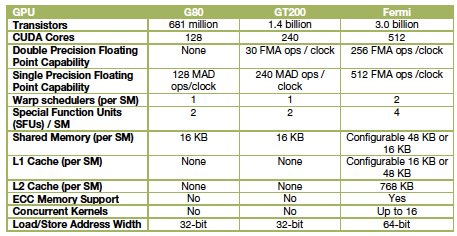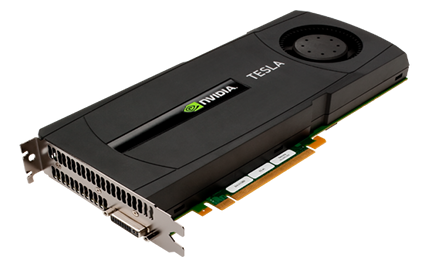Nvidia porting CUDA to x86
Sep 23, 2010 — by LinuxDevices Staff — from the LinuxDevices Archive — 2 viewsNvidia announced that it will port its CUDA (compute unified device architecture) programming language directly to x86 chips. The chipmaker is also touting its next GPU (graphics processing unit), “Kepler,” which will be three or four times more powerful than the current Fermi product, according to industry reports.
Nvidia's CEO Jen-Hsun Huang announced during the company's GPU Technology Conference keynote this week that it would be bringing CUDA directly to x86 chips. CUDA is the computing engine in Nvidia GPUs (graphics processing units) that is accessible to software developers through variants of industry standard programming languages. Huang said a timetable isn't yet set, according to the technology blog Electronista.
In addition, the Wall Street Journal reported Huang as saying Nvidia's next GPU, codenamed Kepler, would debut in late 2011 and be three or four times more powerful than the current Fermi product, without a great increase in power consumption. "There are hundreds of engineers working on it," the Journal reported him saying.
Fermi, announced a year ago at Nvidia's inaugural GPU Technology Conference, amounts to a third generation of products embodying the company's "GPU computing" model. The first generation was the G80 unified graphics/computing architecture, introduced in November 2006 and later embodied in the GeForce 8800, Quadro FX 6500, and Tesla C870 GPU products.
The G80 was the first GPU to replace separate vertex and pixel pipelines with a single unified processor, the first to utilize a scalar thread processor, and the first to support C, according to the company.
The second generation was the GT200, introduced in the GeForce GTX 280, Quadro FX 5800, and Tesla T10 GPUs. The GT200 increased the number of streaming processor cores — subsequently referred to as "CUDA" cores — from 128 to 240. It also added "hardware memory access coalescing," improving memory access efficiency, along with double-precision floating point support, according to Nvidia.

A comparison of Nvidia GPU generations
Source: Nvidia
In January 2010, Nvidia announced Fermi products aimed at the HPC (high performance computing) market in the form of the Tesla C2050 (below) and C2070 boards. Employing the GPUs for general-purpose parallel computing, the devices do not run Windows or Linux directly but, instead, are designed to run C, C++, OpenCL, DirectCompute, or Fortran while a workstation's CPUs perform other tasks, according to the company.

Nvidia's Tesla C2050
(Click to enlarge)
Nvidia says the boards support the next-generation IEEE 754-2008 double-precision floating point standard, and are designed for applications such as ray tracing, 3D cloud computing, video encoding, database search, data analytics, computer-aided engineering, and virus scanning. The C2070 and C2050 support PCI Express 2.0, for "fast and high-bandwidth communication between CPU and GPU," the company adds.
The boards were subsequently incorporated into HPC servers from third-party companies, such as the Appro Tetra 1x26G4 server. For further details of that product and more background on Fermi, see our previous coverage, here.
Given that CUDA appears to be one of Nvidia's crown jewels, it's surprising on the face of it that the company plans an x86 port. No doubt, however, CUDA will run much more slowly on x86 than on Fermi or Kepler, perhaps ultimately driving sales of Nvidia GPUs.
New research and educational programs
This week, Nvidia also announced the addition of research and educational centers dedicated to leveraging the processing power of GPUs to address today's computing issues. "CUDA Research Centers" are recognized institutions that embrace and utilize GPU computing across multiple research fields. "CUDA Teaching Centers" are institutions that have integrated GPU computing techniques into their mainstream computer programming curriculum.
Existing CUDA Research Centers include Johns Hopkins University, California Polytechnic State University and others; among the new centers are locations at University of California at Los Angeles and HP Labs.
Launched in June, the CUDA Research Center program fosters collaboration with research groups at universities and research institutes that are expanding the frontier of massively parallel computing. Among the benefits said to be are events with researchers and academics, a designated Nvidia technical liaison and access to specialized online and in-person training sessions.
"The addition of these new educational programs underscores the tremendous interest in harnessing the power of GPUs to solve today's most pressing computing challenges," said Sanford Russell, general manager of CUDA and GPU computing at Nvidia.
Russell added, "There are more than 350 universities worldwide teaching the CUDA programming model within their curriculum, and more than 100,000 programmers actively developing applications that use the GPU. With the addition of these new programs, we expect to see even broader interest and adoption of GPU computing practices across a wide variety of industries worldwide."
GPUs for consumers
Earlier this year, Nvidia unveiled a new series of GeForce 400M GPUs, including the GeForce GTX 470M and GTX 460M for enthusiast users and the GeForce GT 445M, GT 435M, GT 425M, GT 420M and GT 415M for performance users. The GeForce 400M Series is also able to deliver stereoscopic 3D images when configured with Nvidia 3D Vision glasses and a 3D display. 3D Vision supports an array of 3D content, including more than 425 games, Blu-ray 3D movies, photos, and streaming Web video.
Notebook models featuring the GeForce 400M series and the 3D Vision glasses will be available soon after launch, according to a company release, including the Acer Aspire 5745DG with GeForce GT 425M and the Asus G53Jw with GeForce GTX 460M. In addition, by including support for Nvidia's 3DTV Play technology, users can attach their notebook to a 3D TV and play content that way.
The announcement comes at a time when the company is struggling against competitors such as AMD and Intel. In the second quarter, the GPU maker saw double-digit losses across every segment except for notebooks, where the company grew shipments 10 percent over the first quarter. Nvidia officials announced July 28 that they expect revenues in their fiscal second quarter, which ended July 31, to come in at $800 million to $820 million, down from an earlier projection of $950 million to $970 million.
Further information
More information on Nvidia's CUDA technology may be found on the company's website, here.
Nathan Eddy is a writer for our sister publication eWEEK.
This article was originally published on LinuxDevices.com and has been donated to the open source community by QuinStreet Inc. Please visit LinuxToday.com for up-to-date news and articles about Linux and open source.